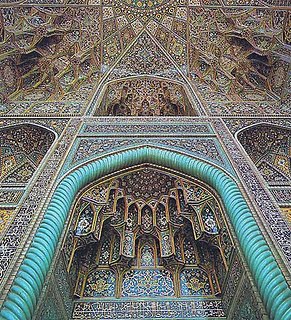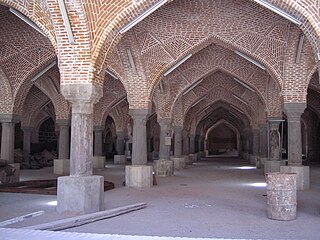
Iranian architecture or Persian architecture is the architecture of Iran and parts of the rest of West Asia, the Caucasus and Central Asia. Its history dates back to at least 5,000 BC with characteristic examples distributed over a vast area from Turkey and Iraq to Uzbekistan and Tajikistan, and from the Caucasus to Zanzibar. Persian buildings vary from peasant huts to tea houses and garden, pavilions to "some of the most majestic structures the world has ever seen". In addition to historic gates, palaces, and mosques, the rapid growth of cities such as the capital, Tehran has brought about a wave of demolition and new construction.

Naqsh-e Jahan Square, also known as Meidan Emam, is a square situated at the center of Isfahan, Iran. Constructed between 1598 and 1629, it is now an important historical site, and one of UNESCO's World Heritage Sites. It is 160 metres (520 ft) wide by 560 metres (1,840 ft) long. It is also referred to as Shah Square or Imam Square. The square is surrounded by buildings from the Safavid era. The Shah Mosque is situated on the south side of this square. On the west side is the Ali Qapu Palace. Sheikh Lotf Allah Mosque is situated on the eastern side of this square and at the northern side Qeysarie Gate opens into the Isfahan Grand Bazaar. Today, Namaaz-e Jom'eh is held in the Shah Mosque.

Goharshad Mosque is a former free standing mosque in Mashhad of the Razavi Khorasan Province, Iran, which now serves as one of the prayer halls within the Imam Reza shrine complex.

A shabestan or shabistan is an underground space that can be usually found in traditional architecture of mosques, houses, and schools in ancient Iran.

Jame Mosque of Qazvin is one of the oldest mosques in Iran, and is the grand, congregational mosque of Qazvin, in Qazvin Province, Iran.

The Jāmeh Mosque of Isfahān or Jāme' Mosque of Isfahān is the grand, congregational mosque (Jāmeh) of Isfahān city, within Isfahān Province, Iran. The mosque is the result of continual construction, reconstruction, additions and renovations on the site from around 771 to the end of the 20th century. The Grand Bazaar of Isfahan can be found towards the southwest wing of the mosque. It has been a UNESCO World Heritage Site since 2012.

The Jāmeh Mosque of Zanjān also known as, Seyyed Mosque and Sultani Mosque, is the grand, congregational mosque (Jāmeh) of Zanjān city, Iran. The mosque is situated in the old part of the city and was constructed in 1826 during the Qajar era. The construction was carried out by Abdullah Mirza Dara who was one of the children of Fat'h ‘Alī Shāh Qājār.

The Jāmeh Mosque is a large, congregational mosque (Jāmeh) in Tabrīz city, within the East Azerbaijan Province of Iran. It is located in the Bazaar suburb of Tabriz next to the Grand Bazaar of Tabriz and the Constitutional House of Tabriz.

Maghsoudbeyk mosque is near the northeastern corner of Naqsh-e Jahan Square. It was built in 1601 by the order of Maghsoudbeyk, who was one of the very rich stewards of Abbas I. There is an inscription in the mihrab of this mosque, which is one of artworks of the famous calligrapher of the Safavid era Ali Reza Abbassi. It's said, after that Shah Abbas was very satisfied with this inscription, he ordered Ali Reza Abbassi to work on the inscriptions of Sheikh Lotfollah Mosque. Behind the entrance hall of the mosque in a small chamber, there's a tomb which is the tomb of Mir Emad, the art rival of Ali Reza Abbassi. Maghsoudbeyk mosque was a very glorious and beautiful mosque in Isfahan in the Safavid era.

The Jarchi mosque was built according to a Thuluth inscription above its spandrel in 1610 under the supervision of Shah Abbas' herald. The word Jarchi means herald in Persian. The mosque has a shabestan and is located in the Great Bazaar (Bazaar-e-Bozorg) of Isfahan. Decorations of this mosque are mainly destroyed.

Rahim Khan Mosque is a historical mosque in Isfahan, Iran. It was built in the late 19th century. This mosque has an unusual combination of styles in architectural decorations. The shabestan of this mosque is one of the biggest shabestans in Isfahan. The shabestan, portal, iwan and outer surface of the mosque's dome have been rebuilt.

Emamzadeh Esmaeil and Isaiah mausoleum is a historical complex in Isfahan, Iran, which dates back to the Seljuk and Safavid era. This complex is located near the Jameh Mosque of Isfahan, in the Hatef street and contains two mausoleums, one believed to be for Esmaeil, one of grandsons of Hasan ibn Ali, and another which is believed to be Isaiah's.

The Khozan mosque is a historical mosque in the Khomeyni Shahr County of the Isfahan Province. The original building of the mosque dated back to the Timurid era in the 15th century, but it's improbable that the current building to be older than the Safavid era. The mosque has four iwans. The southern iwan leads to the inner space of the dome. The inner space of the dome is decorated by muqarnas. The walls of the mosque are covered by stones and bricks. The arches of the northern and southern iwans are decorated with some paintings from the Safavid era., but the paintings of the eastern and western iwans seem to belong to the Qajar era. The shabestan of the mosque is behind the western iwan. There are 20 stone columns with the height of 2 m in the shabestan. The shabestan had been lit originally with the marble stones of the ceiling, but during the recent reparations, these marble stones have been removed.

The Jameh mosque of Kashan is the oldest historical structure in Kashan, Iran. Its only brick minaret is located in its southeastern corner. On the bottom part of the minaret, there is a kufic inscription made by embossed brick. On the inscription, it is mentioned the construction date of the minaret, which is 1074 AD. The minaret is the third oldest minaret in Iran, which has an inscription.

The Meydan mosque is a historical mosque in Kashan, Iran. It is located in the southern side of the Sang-e Ghadimi square and beside the Bazaar of Kashan. It is one of the oldest structures in Kashan. The primary structure belonged possibly to the seljuq era, but it was destroyed by the Mongols during their invasions. Later it was rebuilt and repaired by Khaje Emad ed-Din. A quotation for this matter is an inscription in the old mihrab, in which it is mentioned that it is built in 623 Hijri by Hassan ebn-e Arabschah in Kashan. The mihrab was in its original place until the last century, but it is kept now in the Museum of Islamic art in Berlin.

The Tabriziha mosque is a historical mosque in Kashan, Iran. The mosque is located in Malek bazarche and belongs to the Qajar era. It was built by Mohammad Hosseyn Tabrizi. Both sides of its big door have been decorated with haftrang tiles. Its vestibule has a stucco inscription. The ceiling of its shabestan has 18 arches, which have been decorated with bricks and tiles. The columns have been covered with tiles. The four sides of shabestan and around the coloumns there are inscriptions of the verses of Koran. The inscriptions have been written in white Naskh on a persian blue background. The triangle under the inscriptions have been decorated with designs and shapes. The mihrab of the mosque has been decorated with tiles and has a stucco inscription. On the inscription, some Koran verses have been written in white Thuluth script on the ultramarine background.
Mohammad Reza Emami was a Persian calligrapher in the 17th century. He lived from the era of Abbas I until the era of Suleiman I. He was Ali Reza Abbassi's student and was known as the Imam of calligraphers.

The Jameh mosque of Golpayegan is one of the important mosques of the Seljukid era and one of the large mosques in Iran. In view of its construction date, it may be said that its iranian islamic architecture was a model for building other large mosques specially the mosques, which were in the territory of seljukid dynasty. This mosque is located in the Masjed Jameh street in Golpayegan.

The Amir Chakhmaq mosque, also known as Dahouk mosque, is a historical mosque from the Timurid era in Yazd, in Iran. It was built on orders of Jalal ed-Din Amir Chakhmaq Shami, who was the governor of Yazd and a general of Shahrukh Mirza. The mosque was completed in 1438. From the viewpoint of aesthetics, dimension and importance, it is one of the most outstanding buildings in Yazd.
















